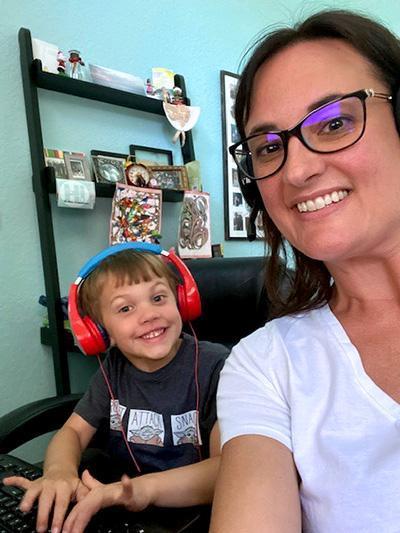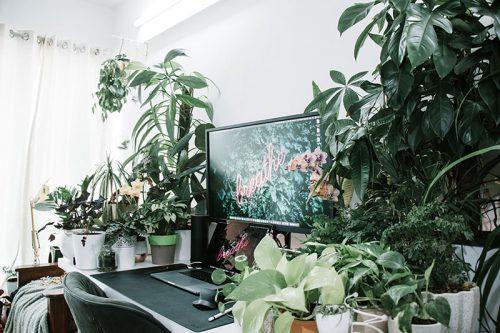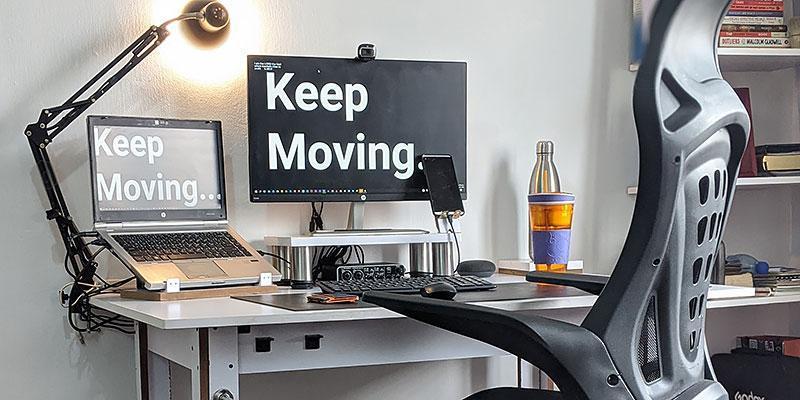It’s official! We are more than a year into COVID and the shift to working from home. For some, this was an abrupt change and their first time working remotely. For others, the change was having everyone else working from home too and seeing clients and colleagues learn the ropes.
This is my eighth year working full-time from my home office. There used to be a lot more travel and work taking place in airports and hotel lobbies, but I have not been in an office full-time since I left “law firm world”. Interestingly, the main reason I left the firm and shifted to the service provider realm was because I was moving and it was against firm policy to work remotely. Oh, how things can change in the blink of an eye!
Since I have been doing this for a while, last year I posted on LinkedIn some tips and tricks to help those transitioning to a remote environment. This year, I would like to add a few additional thoughts, as well as information on the extremely important and highly relevant topic of technology and security.

Finding Success in a Remote Environment
Setting Expectations
My workday begins with a quick check of email to address anything from our teams outside the U.S. as I also get my son ready for school. For most of the past year, my son shared an office with me where he “went” to Kindergarten. Though I miss my officemate, luckily, he was able to go back to school this quarter so there is a little more room in my office these days.
It is imperative that you, as an employee, set the proper expectation of your workday. The same is true for managers — putting clear guidelines in place helps everyone. Some examples are:
- What hours will you be logged in and available?
- Are you expected to respond to messages and calls outside of your set hours? If so, up until what time?
- I recommend that you set clear boundaries as to when the workday ends and not respond to emails after a certain time as it can set the precedence that you are available at any time. If you must send emails after hours that do not require an immediate response, either schedule them to send in the morning or make it clear that a response is not required until regular hours.
- What is the response time others can expect and that you expect from others (10 mins, 30 mins, etc.)?
- Are there points in the day when you are not available?
- My house has a device-free dinner rule where no phones are allowed at the table while we eat. My team knows that I am unavailable for this period.
- What are the metrics you are being measured against?
- Without face-to-face, managers may have different requirements of their team. Ensure that everyone is on the same page and operating under the same guidelines.
- What technology should be used for meetings and communication (Teams, Slack, Zoom, other)?
- Encourage cameras on, without making others feel uncomfortable.
My company uses Microsoft Teams for all meetings and typically we encourage cameras turned on. While I dread this at times, it has really helped maintain the camaraderie across the team. I am in a unique position as my first day of work was March 23 last year; the week after the world shut down. This means I have not met face to face with most of the team so being able to at least see each other over Teams has been a big help. This same philosophy carries over to client calls. Even if I end up being the only one on camera, I think it shows engagement.
As a means of getting to know my team better, I invited everyone to a weekly “coffee break” designed as a stress-free chat. This is optional 30-minute get together scheduled at the same time each week is open to anyone that is available. Most of these calls include some work discussion and some non-work discussion. We are a geographically diverse team, so this is a great way to get together pandemic or no pandemic. These calls have been going for about six months and the attendance is still strong.
Work Environment
Security issues aside, having an area dedicated to working helps you mentally prepare for your day.
Avoid working in your bedroom. When working from home, it is hard enough to shift gears between “work brain” and “home brain”. Working from the same room where you sleep also makes that even harder. And, if you have no choice, do as your mother told you and make your bed – you will feel more organized and focused.
Ideally, you need a dedicated space, preferably with a door if others are at home with you. You should have a desk, proper lighting, and a comfortable chair. If you have not done so already, check with your company about getting a second monitor and see if they will help with an ergonomic chair since you are spending much of your day sitting.
Your internet should also be optimized for the number of people in your house trying to stream meetings. It may help to disable Wi-Fi on devices that are not being used during the day like tablets and streaming services to open bandwidth.
Social Interactions
Now more than ever, maintaining social interactions is vitally important. While in-person meetings and lunches are for the most part a thing of the past, there are still many opportunities for virtual meetups. Zoom fatigue is a real thing so do not over-extend yourself with so many social meetings that you get burned out.
A few things that have benefited me:
- Take a class. There are a ton of free or inexpensive classes available through LinkedIn and edX, to name a few. Depending on your industry, many technology providers also offer free training and certifications. Try something of interest whether it relates to your current role or not. Blockchain anyone?
- Attend webinars. LinkedIn displays upcoming webinars based on your network. Industry organizations and tech providers also offer some great content. This is also a are a terrific way to build your network.
- Find virtual industry events. Virtual industry meetings have really helped me stay connected and expand my network over the past year, without ever leaving my house. There is also a plethora of online conferences that can be found again on LinkedIn through industry organizations and your personal network.
- Get involved with a charity. Volunteering may have been difficult to fit in when you were commuting to an office, but virtual volunteering may fit both your schedule and your need for social interaction and helping others. My local United Way has done a great job of offering content and opportunities to get involved remotely.
- Create your own. If you cannot find something of interesting to you, create it! Maybe set-up your own coffee break, virtual lunch, or put together a Zoom trivia night.
Security and Confidentiality
 Security is the number one concern for companies when it comes to remote work. This is something that you, or anyone else working or going to school at home, should keep in mind. Every 11 seconds a cyber incident occurs and a whopping 94% of malware attacks come through email. Human error accounts for over 20% of all cyberattacks. You likely signed an Acceptable Use Policy with your company. It may be a good time to go back and review it to ensure you are complying.
Security is the number one concern for companies when it comes to remote work. This is something that you, or anyone else working or going to school at home, should keep in mind. Every 11 seconds a cyber incident occurs and a whopping 94% of malware attacks come through email. Human error accounts for over 20% of all cyberattacks. You likely signed an Acceptable Use Policy with your company. It may be a good time to go back and review it to ensure you are complying.
Maintaining client confidentiality is paramount and client expectations are the same regardless of the location or situation you are in. If you are sharing a workspace with others, even family members, you must ensure that you understand what is considered confidential and decide the best way to handle conversations that may involve sensitive information when others are present. Precautions to consider include not using a speaker phone when others could hear the conversation, making sure your computer screen cannot be seen by anyone else, setting a screen lock and locking your computer each time you get up, and making sure no papers are out in the open that may contain client information.
Do not share computers or company-managed technology with anyone else. This is likely against your Acceptable Use Policy and can also lead to unfortunate issues. Remember the news story of the attorney from Texas who was in a web meeting with a judge and opposing counsel and he could not turn off the cat filter? “Judge, I’m here and I’m not a cat.” Turns out he was using his legal assistant’s computer who had a filter turned on. While this could have been much worse, it was also easily prevented.
Finally, ensure that your Wi-Fi connection is secured. This means changing the password of your home wireless to something unique and complex. This also means not using unsecured connections in public (meaning, no password required). This is an easy way to prevent one of the many security attacks that occur over unsecured internet connections.
Risks of Shadow IT
Shadow IT is defined as the use of technology, devices, software, hardware, and applications without the explicit approval of your Information Technology department. Gartner estimates that at least one third of cyber attacks come from the use of Shadow IT.
Examples of shadow IT include:
- Chat apps like WhatsApp, Slack, Skype
- Personal email accounts used for business purposes
- Unsanctioned use of document repositories like DropBox and Google Docs
- Social media when accessed via company devices
- Digital assistants like Apple’s Siri, Amazon Alexa, and Google Home. In fact, many companies prohibit the use of these devices in areas where client conversations may happen due to the potential of hackers accessing the voice history.
Why is shadow IT an issue? Let’s say you are working on a client document and keep getting booted from your company’s VPN. You decide to forward the document to your personal email address so you can work on it uninterrupted outside of the VPN environment. The problem is that by sending emails to a non-work account, the information the messages contain now sits in an environment that is not secured by your company, leaving the data vulnerable to cyber criminals. You have also opened yourself up to issues by forwarding confidential client information to a personal address (easily found during an audit).
Other potential risks include:
- Introduction of viruses into environment
- Phishing scams
- Cyber incidents (Do you use the same password for both work and personal accounts? Cyber criminals can access multiple accounts once they have your password.)
- Regulatory issues
- HIPAA and personal information leaks
- GDPR/CCPA/privacy
- Goes against the risk management and compliance protocols of your company
- Can open you up to personal lawsuits by operating intentionally outside of your company’s IT environment
- Against your company’s Use Policy and could lead to termination in many cases
Limiting the use of shadow IT is one of the easiest ways you can help prevent a cyber-attack on your company. Use only verified applications and technology for anything work related. Do not use work arounds. If something does not work properly or you are struggling with technology to get your job done, address it with your IT team. Trust me, they would much rather spend the time troubleshooting and fixing the issue than notifying you and the Board that there has been a cyber attack.
Mental Health is a Priority
 Some people love working from home. They feel like they have more hours in the day to focus on work and a better work/life balance. Others are not comfortable working from home. They need the office atmosphere to perform their best. Regardless of what side you fall on, you must take the time, especially with the additional stress created by COVID, to gauge and prioritize your mental health.
Some people love working from home. They feel like they have more hours in the day to focus on work and a better work/life balance. Others are not comfortable working from home. They need the office atmosphere to perform their best. Regardless of what side you fall on, you must take the time, especially with the additional stress created by COVID, to gauge and prioritize your mental health.
This will look different for everyone. Some people react positively to mindfulness and taking a few minutes to check in with themselves or using mindfulness techniques. Some look to hobbies like cooking or crafting to help them relax. Everyone could benefit from some device-free downtime to get fresh air and enjoy the people and activities that help them to unwind. I know some people who take a walk in the morning and evening as if they are commuting to and from work to frame the day and reframe their mind.
Regardless of what you do, remember that just because you work from home does not mean that you cannot from time-to-time get up, walk away, close the door, and enjoy the rest of the day.
References
Cyber statistics:
https://www.csoonline.com/article/3153707/top-cybersecurity-facts-figures-and-statistics.html
https://www.grcworldforums.com/breaches-and-vulnerabilities/human-error-remains-the-main-cause-of-data-breaches/386.article
https://theprint.in/tech/in-2021-there-will-be-a-cyberattack-every-11-seconds-heres-how-to-protect-yourself/565616/#:~:text=Cybersecurity%20experts%20predict%20that%20in,every%2040%20seconds%20in%202016
Shadow IT:
https://kmicro.com/what-is-shadow-it/
https://www.bmc.com/blogs/shadow-it/


